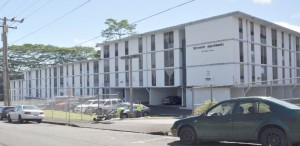Bank Stabilization, Renovations Planned for Riverside Apartments
The Wailuku River is getting a little too close to the Riverside Apartments.
Again.
That means for the second time in as many years, a soil stabilization project is needed for the Puueo neighborhood landmark.
The 74-unit affordable housing complex on Hilo’s Ohai Street is located on a bluff above the Wailuku.
Actually, according to a final environmental assessment for the project, it sits on a three-level terraced bank. In some places, the edge of the bank is less than 10 feet from the building.
In 2008, as a result of heavy rains, a section of the slope closest to the building’s Wainaku Street end gave way, prompting emergency repairs to the bank.
Those were completed in July 2011.
According to the EA prepared by Kimura International of Honolulu, geotechnical studies done as part of that repair also found problems with the slope behind the middle of the L-shaped building.

The vegetation on the right is growing at the edge of the river bank, which shows the slope’s proximity to the building. Photo by Kimura International.
The studies, which included seven exploratory borings, found that slope could collapse during an earthquake or if it became saturated by rain.
“Because of the close proximity of the apartment building to the steep embankment, a landslide in this area could cause severe structural damage to the apartment building, and possibly endanger its tenants,” the environmental assessment said.
The remedy, according to the EA, is similar to the work done in 2011 and has several components.
It includes the insertion of about 200 “soil nails” deep into the bank to help secure the slope, which will then be covered by a layer of “shotcrete” or cement blown onto the surface.
That surface will include a drainage system with a cutoff wall at the bottom to protect it against the scouring effects of the river during high water levels.
There will be seven rows of soil nails consisting of steel bars grouted into holes drilled 20 to 40 feet deep, the EA said.
Another method considered was the building of large concrete caissons or foundations to buttress the building, but that alternative was rejected because there was insufficient room between the building and the bank’s edge for the large drill rigs that would require.
In addition to the soil nails, up to three dozen “micropiles” – high-strength steel bars encased in cement with a galvanized steel casing – will be secured to the building’s footings to give it greater stability. Each micropile will be about six inches in diameter and extend 60 feet into the ground.
After all that is installed, the level area at the top of the bank will be paved to provide additional support and to prevent rain from seeping into and undermining the ground.
The soil stabilization, which is expected to begin late this year, is being required by the US Department of Housing and Urban Development, which provides Section 8 housing subsidies for the apartments.
It will be done in conjunction with the renovation of the interior and exterior of the apartment building.
The improvements to the building’s apartments will include new flooring, carpeting and appliances as well as painting. Repairs and upgrades to plumbing and electrical systems will also be done.
The building, which was built in 1973, will also get a new paint job on the exterior as well as a new roof, upon which photovoltaic panels will be installed.
The stabilization effort is expected to take about four months to complete.
The environmental assessment said both that project and the building’s renovations are being funded through state and federal tax credits and a nearly $8 million loan from the Hawaii Housing Finance and Development Corp.
Riverside Apartments, which is currently owned by a non-profit corporation, is in the process of being sold to UHC 00382 Hilo, a limited partnership formed to purchase, own, operate and improve the apartment building, the environmental assessment said.










